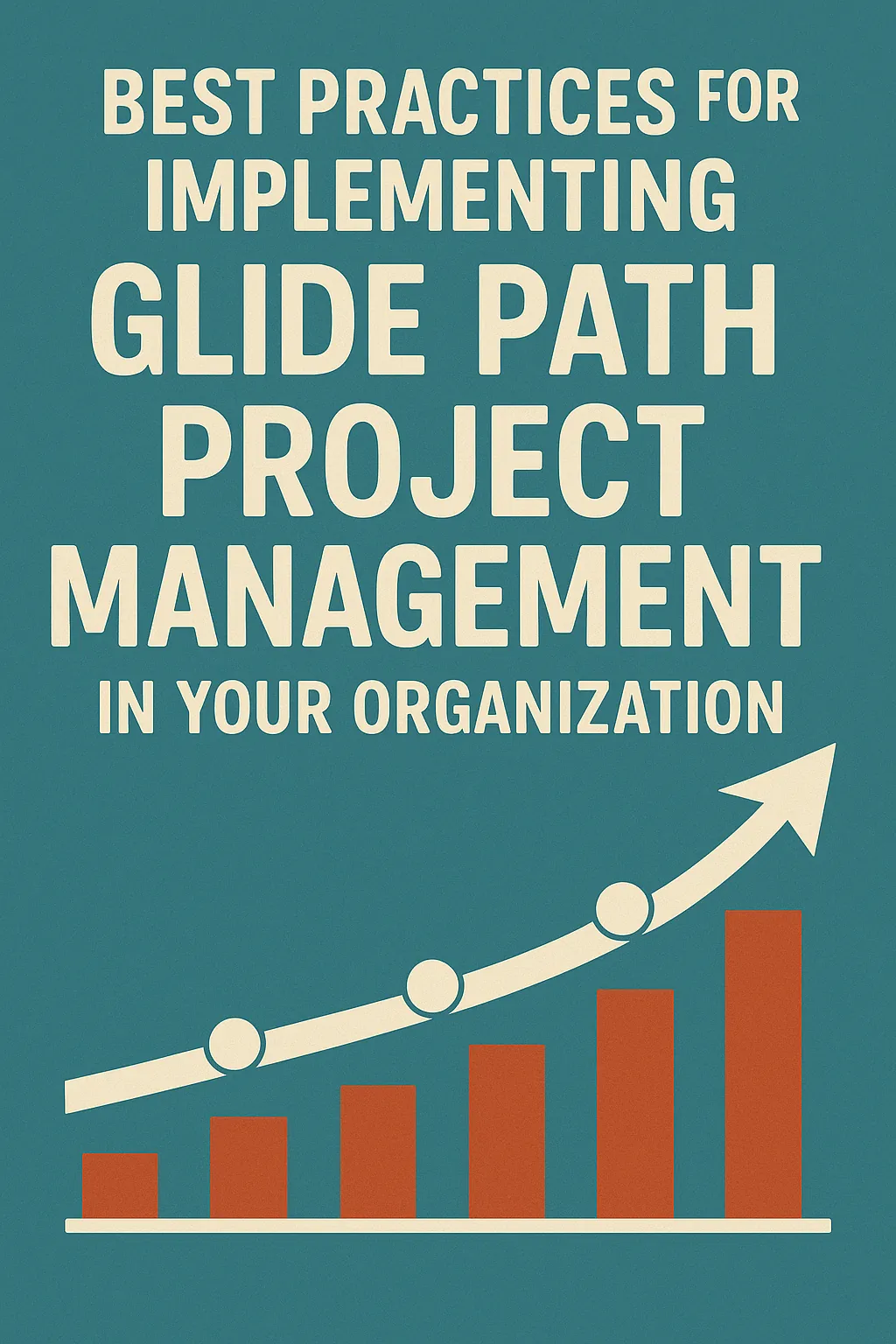Introduction to Glide Path Project Management
The concept of a glide path has emerged as a pivotal approach that enhances the efficiency and adaptability of project execution. Glide path project management is defined as a structured trajectory that outlines the necessary steps and milestones required to achieve project goals. This method emphasizes flexibility and responsiveness, allowing project teams to navigate through complexities and uncertainties effectively. Just as an aircraft follows a specific path to ensure a successful landing, project teams utilize a glide path to ensure timely completion of deliverables and alignment with strategic objectives [10].
Importance in Organizational Project Management
The significance of glide path project management lies in its ability to provide a clear framework for tracking progress against established benchmarks. This approach not only helps in identifying key milestones and deliverables but also ensures that all tasks remain on track to meet final objectives [11]. By establishing a glide path, organizations can create a visual tool that outlines expected progress from the starting point to the ultimate goal, facilitating better communication and collaboration among team members. This is particularly crucial in dynamic environments where project requirements may evolve, as it allows teams to adapt their strategies in real-time while maintaining focus on overarching goals [15].
Comparison with Traditional Project Management Methodologies
When comparing glide path project management to traditional methodologies, several key differences emerge. Traditional project management often follows a rigid, prescriptive process, which can limit flexibility and responsiveness to change. In contrast, glide path project management promotes a more adaptable approach, allowing teams to modify their plans as needed based on ongoing assessments and feedback [2]. This flexibility is essential in today’s fast-paced business landscape, where project success is increasingly dependent on the ability to pivot and respond to new challenges and opportunities.
Moreover, glide path project management expedites project initiation by providing comprehensive templates and processes, enabling teams to get started quickly without the need to develop everything from scratch [3]. This streamlined approach not only saves time but also enhances the overall effectiveness of project management practices within organizations.
Understanding the Glide Path Concept
The glide path concept in project management serves as a crucial tool for visualizing and managing the trajectory of a project. It outlines the necessary steps and milestones required to achieve project goals, akin to how an airplane follows a specific path to ensure a successful landing. Here are some key aspects of the glide path concept and its application in project management:
- Visual Representation of Project Progress: A glide path provides a clear visual representation of a project’s progress over time. It allows project managers and stakeholders to see where the project currently stands in relation to its planned timeline and objectives. This visual aid is essential for maintaining focus and ensuring that all team members are aligned with the project’s goals and deadlines [10].
- Tracking Project Milestones and Timelines: Glide paths are instrumental in tracking key milestones and timelines throughout the project lifecycle. By establishing predefined milestones, project teams can monitor their progress and make necessary adjustments to stay on track. This structured approach helps in identifying potential delays early on, allowing for timely interventions to keep the project moving forward [10].
- Benefits in Project Forecasting and Risk Management: Utilizing glide paths enhances project forecasting and risk management capabilities. By clearly outlining the expected trajectory of the project, teams can better anticipate challenges and allocate resources effectively. This proactive approach to risk management enables organizations to mitigate potential issues before they escalate, ultimately leading to more successful project outcomes [10].
Incorporating the glide path concept into project management practices can significantly improve an organization’s ability to manage projects efficiently. By leveraging this tool, project managers can enhance visibility, accountability, and adaptability, ensuring that projects are completed on time and within budget.
Key Strategies for Successful Adoption
Implementing glide path project management can significantly enhance the efficiency and effectiveness of project delivery within an organization. Here are some critical strategies to facilitate its successful adoption:
1. Assessing Organizational Readiness for Glide Path Implementation
Before diving into the implementation of glide path project management, it is essential to evaluate the organization’s current project management practices and culture. This assessment should include:
- Current Processes: Review existing project management methodologies to identify gaps and areas for improvement. Understanding how projects are currently managed will help in tailoring the glide path approach to fit the organization’s needs [10].
- Resource Availability: Ensure that the necessary resources, including tools and personnel, are available to support the glide path methodology. This includes validating labor availability and verifying material costs to ensure that the organization can meet the demands of the new approach [3][4].
- Cultural Readiness: Gauge the organization’s openness to change. A culture that embraces flexibility and adaptability is more likely to succeed in implementing glide path project management, which emphasizes a streamlined and adaptable approach [11].
2. Engaging Stakeholders and Securing Leadership Buy-In
Successful implementation of glide path project management requires the support and engagement of key stakeholders, particularly organizational leaders. Strategies to secure this buy-in include:
- Communicating Benefits: Clearly articulate the advantages of glide path project management, such as improved project tracking, enhanced milestone management, and better alignment with organizational goals. Highlight how these benefits can lead to successful project outcomes and overall business performance [12].
- Involving Stakeholders Early: Engage stakeholders from the outset to gather input and address concerns. This involvement fosters a sense of ownership and commitment to the new methodology, making it more likely to be embraced across the organization [10].
- Establishing a Benefit-Tracking Office: Create a dedicated team or office to monitor the benefits of glide path implementation. This team can track progress, measure success against established benchmarks, and provide feedback to stakeholders, reinforcing the value of the new approach [2].
3. Creating a Comprehensive Training Program for Project Management Teams
To ensure that project management teams are well-equipped to implement glide path project management, a robust training program is essential. Key components of this program should include:
- Tailored Training Sessions: Develop training sessions that are specific to the glide path methodology, focusing on its principles, tools, and techniques. This training should cater to different levels of expertise within the project management team [11].
- Hands-On Workshops: Incorporate practical workshops where team members can apply glide path concepts to real projects. This experiential learning approach helps solidify understanding and builds confidence in using the new methodology [10].
- Ongoing Support and Resources: Provide continuous support through resources such as guides, templates, and access to expert advice. This ongoing assistance will help project managers navigate challenges as they adopt the glide path approach [12].
By following these strategies, organizations can effectively implement glide path project management, leading to improved project outcomes and enhanced overall performance.
Integrating Glide Path into Existing Project Management Frameworks
Incorporating glide path methodologies into your organization’s project management practices can significantly enhance project success rates. Here are key strategies to ensure a seamless integration:
Identifying Areas Within Existing Frameworks that Align with Glide Path Principles
- Flexibility and Adaptability: One of the core principles of glide path project management is its emphasis on flexibility. Review your current project management framework to identify processes that may be too rigid. Look for opportunities to introduce more adaptive practices that allow for adjustments based on project progress and stakeholder feedback. This aligns with the glide path’s focus on managing projects in a dynamic manner rather than adhering strictly to a prescriptive process [1].
- Milestones and Deliverables: Assess how your existing framework defines milestones and deliverables. Glide path methodologies emphasize the importance of clearly defined milestones that guide project teams toward their goals. Ensure that your current processes include checkpoints that facilitate tracking progress and making necessary adjustments [10][11].
Developing a Customized Glide Path Model Tailored to the Organization’s Needs
- Tailored Approach: Every organization has unique challenges and objectives. Develop a glide path model that reflects your specific context, including industry standards, team capabilities, and project types. This customization will help ensure that the glide path is relevant and effective in guiding project teams toward successful outcomes [1][8].
- Long-term Planning: As part of your glide path model, establish a long-term vision that outlines the trajectory for project success over time. This should include a documented plan for improving competency, performance, and business results, which can serve as a roadmap for project teams [8].
Utilizing Technology and Tools that Support Glide Path Visualization and Tracking
- Project Management Tools: Leverage technology to enhance the visualization and tracking of glide paths. Utilize project management software that allows for the creation of visual representations of the glide path, making it easier for teams to understand their progress and the steps needed to reach their goals. This can include Gantt charts, dashboards, and other visual aids that provide real-time updates on project status [3][10].
- Data-Driven Decision Making: Implement tools that facilitate data collection and analysis to monitor project performance against the glide path. This will enable project managers to make informed decisions and adjustments as needed, ensuring that the project remains on track to meet its objectives [2][11].
By focusing on these strategies, organizations can effectively integrate glide path methodologies into their existing project management frameworks, leading to improved project outcomes and enhanced team performance.
Monitoring and Adjusting Glide Paths
Effective glide path project management is not a one-time effort; it requires ongoing monitoring and adjustments to ensure that projects remain on track and achieve their intended outcomes. Here are some key strategies for successful adoption and implementation of glide path management in your organization:
- Establishing Key Performance Indicators (KPIs): To measure the effectiveness of glide paths, it is crucial to define clear KPIs. These indicators should align with project goals and provide quantifiable metrics that can be tracked over time. By establishing KPIs, project teams can assess whether the glide path is facilitating progress towards objectives and identify areas that may require intervention or adjustment [6][10].
- Regularly Reviewing and Adjusting Glide Paths: Continuous monitoring of project performance is essential. Regular reviews allow project managers to evaluate the current status against the established glide path and make necessary adjustments. This proactive approach helps in identifying deviations early, enabling teams to implement corrective actions before issues escalate. It is recommended to schedule these reviews at key project milestones or intervals to maintain alignment with project goals [1][9].
- Incorporating Feedback Loops for Continuous Improvement: Feedback loops are vital for fostering a culture of continuous improvement within project management. By soliciting input from team members and stakeholders, organizations can gain insights into the effectiveness of the glide path and identify potential enhancements. This iterative process not only improves the current project but also informs future glide path strategies, ensuring that lessons learned are integrated into subsequent initiatives [2][10][15].
Common Challenges and Solutions
Implementing Glide Path Project Management can significantly enhance project outcomes, but organizations often encounter several challenges during adoption. Below are some common obstacles along with actionable solutions to facilitate a smoother transition.
1. Resistance to Change Among Team Members
Resistance to change is a prevalent issue when introducing new project management methodologies. Team members may feel apprehensive about altering established workflows or fear that new processes could complicate their tasks.
Solutions:
- Engagement and Communication: Foster an open dialogue about the benefits of Glide Path Project Management. Involve team members in discussions and decision-making processes to create a sense of ownership and reduce apprehension.
- Training and Support: Provide comprehensive training sessions that not only explain the Glide Path methodology but also demonstrate its practical applications. Continuous support can help ease the transition and build confidence among team members [1][2].
2. Complexity in Integrating Glide Paths into Diverse Project Types
Organizations often manage a variety of projects, each with unique requirements and challenges. Integrating Glide Path methodologies into these diverse project types can be complex and may lead to inconsistencies in application.
Solutions:
- Tailored Frameworks: Develop customized Glide Path templates that cater to the specific needs of different project types. This approach allows for flexibility while maintaining the core principles of Glide Path management.
- Pilot Programs: Start with pilot projects to test the Glide Path approach in various contexts. Gather feedback and refine the process before a full-scale rollout, ensuring that the methodology is adaptable to different project environments [3][4].
3. Mitigating Risks Associated with Misalignment in Project Goals and Glide Paths
Misalignment between project goals and the established Glide Path can lead to confusion, inefficiencies, and ultimately project failure. Ensuring that all stakeholders are aligned is crucial for successful implementation.
Solutions:
- Clear Goal Definition: At the outset of each project, clearly define the goals and objectives. Ensure that these are communicated effectively to all team members and stakeholders involved in the project.
- Regular Monitoring and Adjustments: Implement a continuous monitoring system to track progress against the Glide Path. Regularly review and adjust the path as necessary to align with any changes in project goals or external factors. This proactive approach helps in identifying misalignments early and allows for timely corrective actions [5][6].
By addressing these common challenges with strategic solutions, organizations can enhance their adoption of Glide Path Project Management, leading to improved project outcomes and greater overall efficiency.
Case Studies: Successful Implementation of Glide Path Project Management
The glide path concept has emerged as a powerful tool for ensuring that projects are completed on time and within scope. This section highlights organizations that have successfully implemented glide path project management, providing insights into their experiences, key takeaways, and the overall impact on project outcomes and organizational efficiency.
Overview of Organizations
- Aerospace Company: A leading aerospace manufacturer adopted glide path project management to streamline its complex product development processes. By defining clear milestones and deliverables, the organization was able to enhance communication among teams, leading to improved collaboration and reduced project delays.
- Construction Firm: A major construction company implemented glide path strategies to manage multiple concurrent projects. By utilizing predefined trajectories for each project, the firm was able to allocate resources more effectively and minimize conflicts, resulting in a significant reduction in project overruns.
- IT Services Provider: An IT services provider integrated glide path methodologies into its software development lifecycle. This approach allowed the team to monitor progress closely and make real-time adjustments, which led to higher quality deliverables and increased client satisfaction.
Key Takeaways and Lessons Learned
- Effective Communication is Crucial: Successful implementation of glide path project management hinges on clear communication among all stakeholders, including project teams, clients, and management. Regular updates and feedback loops help ensure everyone is aligned with project goals and timelines [1].
- Define Clear Milestones: Establishing specific milestones and deliverables is essential for tracking progress. Organizations that clearly defined their glide paths reported better visibility into project status and were able to identify potential issues early on [10].
- Flexibility and Adaptability: While glide paths provide a structured approach, organizations learned the importance of remaining flexible. The ability to adapt to changing circumstances and project requirements was vital for maintaining momentum and achieving project goals [9].
- Continuous Monitoring and Control: Implementing a robust monitoring system allowed organizations to track progress against their glide paths effectively. This proactive approach enabled teams to address risks and issues promptly, ensuring projects stayed on track [11].
Impact on Project Outcomes and Organizational Efficiency
The adoption of glide path project management has led to significant improvements in project outcomes and overall organizational efficiency:
- Enhanced Timeliness: Organizations that implemented glide paths reported a marked increase in on-time project completions. By following a predefined trajectory, teams were better equipped to manage their time and resources effectively [10].
- Improved Resource Allocation: Glide path methodologies facilitated better resource management, allowing organizations to allocate personnel and materials more efficiently. This optimization resulted in cost savings and reduced waste [6].
- Higher Quality Deliverables: The structured approach of glide path project management contributed to improved quality in project outputs. Teams were able to focus on critical tasks and ensure that deliverables met or exceeded client expectations [9].
- Increased Stakeholder Satisfaction: By delivering projects on time and within budget, organizations experienced higher levels of satisfaction among stakeholders, including clients and team members. This positive feedback loop further reinforced the value of glide path strategies in project management [10].
Conclusion
In conclusion, adopting Glide Path Project Management can significantly enhance the effectiveness and efficiency of project execution within your organization. This approach offers several benefits, including:
- Streamlined Processes: Glide Path Project Management emphasizes a flexible and adaptable methodology, allowing teams to navigate projects with greater ease and responsiveness to changes, which can lead to improved project outcomes [10][11].
- Clear Milestones and Trajectories: By defining a clear trajectory for project goals, organizations can ensure that all team members are aligned and focused on achieving specific deliverables, thereby reducing the risk of project delays [10].
- Enhanced Collaboration: The integration of Glide Path principles fosters better communication and collaboration among project teams, which is crucial for successful project management [3].
As organizational leaders, it is essential to assess your current project management practices critically. This evaluation will help identify areas for improvement and determine how well your existing processes align with the principles of Glide Path Project Management. Consider the following steps:
- Conduct a Readiness Assessment: Evaluate whether your organization is prepared to implement and sustain the Glide Path approach. This includes assessing governance structures and stakeholder engagement [1].
- Engage Stakeholders: Work closely with all relevant stakeholders to gather insights on their experiences and expectations regarding project management. This collaboration will help tailor the Glide Path approach to meet your organization’s specific needs [4].
Embrace the Glide Path Project Management approach today, and position your organization for future success in project execution.
Find out more about Shaun Stoltz https://www.shaunstoltz.com/about/.
This post was written by an AI and reviewed/edited by a human.



